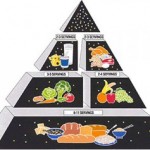Twenty years ago, there was one model that every America could reference for healthy eating - the USDA Food Pyramid. Taped up to the walls of public school cafeterias or illustrated on the back of cereal boxes, everyone from expert to everyday citizen seemed to agree on the definition of the optimal diet. Daily, it included: 6 – 11 from the grains group (bread, cereal, rice, pasta), 3 – 5 servings of vegetables, 2 – 4 servings of fruit, 2 – 3 servings of protein (meat, poultry, fish, dry beans, eggs, nuts), 2 – 3 servings of dairy (milk, cheese), and then the triangle topped off with the “use sparingly” foods (fats, oils, sweets).
Looking back now, how did that model work out for us?
Statistically speaking, the answer is not very well.
As stated by the Centers for Disease Control and Prevention: “During the past 20 years, there has been a dramatic increase in obesity in the United States and rates remain high.”
Hence why the USDA sent a wrecking ball through the food pyramid and then set a plate in its place. This new circular model acts as a pie chart for what proportions of what foods constitute an appropriate meal. It also includes a cup of milk to the side.
While we hope the new icon provides a better strategy in America's ongoing battle with rising obesity rates, we kind of wish the government had consulted entreQuest first. We might have been able to save them some of the costs related to overhauling their collateral from pyramid to plate.
Since our the earliest days of our business, we have guided our clients with a triangle and it has been so successful that we could never dream of even slightly changing it. It is called the Achievement Model and it contains three simple layers. The bottom and largest layer is MINDSET. The middle layer is PROCESS. And the top layer is RESULTS.
Please read the entreQuest article published in SmartCEO for more information on the Achievement Model at this link: http://www.entrequest.com/wp-content/pdf/entrequest_November_11.03pdf.pdf?phpMyAdmin=d2c4aa6766ft5760658.
So if MINDSET is the foundation for the PROCESSES that create RESULTS, and the desired result is a healthy state of being, then a food plan is a process to achieve such. And it all must rest upon a mindset that is determined and focused.
Bearing that in mind, what would entreQuest have done with the food pyramid? Simple. We would have consolidated every piece of it – grains, vegetables, fruits, proteins, dairy products, and “use sparinglys” into the middle layer because portion control and food choices are just processes. Then we would have made the very top layer represent a healthy lifestyle since that is the stated goal. Most importantly though, we would have established mindset as the base because if Americans do not really believe that they can become healthier, how can they ever change their bad habits into good ones and make the right decisions over the wrong ones? Every single reminder and recommendation in the world for what leads to a healthy lifestyle could be tattooed to their hand but if they’re not bought into their mission, that hand could still reach for a dozen donuts with a side of French fries and a supersized milkshake when the cravings come a calling. Without mindset, processes cannot result in achievement.
It’s the same with a business. A leader can hire only Ivy League educated candidates and then equip them with only the fastest technology and present them with a perfect day-to-day strategy for performance improvement. However these types of processes will do nothing if the team members have not made up their mind to better themselves and better their organization. If employees are not compelled to be the cause of their own success and the success of their company then how can the company ever survive the uphill battle to achievement? A bad economy or tough competition or even a bad day will deter even the most competent professional’s productivity if their mindset is not aligned to a greater mission. For corporate growth to occur, each team member must make up his or her mindset to reach goals and live up to both their own potential as well as their company’s values.
The obvious question here is how do you compel your people to master their mindset? We suggest to our clients that you help them understand the story they are a part of – the story of your company. If they are not inspired by their company’s values, empowered by their company’s beliefs, and charged by their company’s mission, how can they ever be expected to be inspired, empowered, and charged enough to go through the proper processes and generate real results?
Understanding the story is not a one-time deal. It is an ongoing journey. The most loyal following must still be constantly reminded of the mission at hand. There are a lot of negative forces out there that will tempt people towards inaction, indifference, falter, and failure. Like minds, mindsets tend to wander and therefore people must be refreshed about the WHY they are doing what they are doing. Leaders, managers, and frontline staff members must remain motivated through consistently themed messaging in all programs and protocol throughout the company. Growth is a process and it is a result but without mindset, growth will be neither.
That goes for healthy lifestyles too. When Americans are motivated to believe in themselves and embody their success story, their mindset will drive the processes that deliver results. Only unlike business, these results won’t be growth in the physical sense...
Joe Mechlinski is the President of entreQuest and has partnered with countless leaders to effectively improve their team’s performance, their clients’ experience, and their company’s profits.
(*Information Sources:
"USDA Food Pyramid Out: Is the New Food Plate Better?" The Huffington Post. Thursday 2 June 2011. http://www.huffingtonpost.com/2011/06/02/food-pyramid-usda_n_870375.html?view=screen.
"U.S. Obesity Trends." Centers for Disease Control and Prevention. Thursday 21 July 2011. http://www.cdc.gov/obesity/data/trends.html.)








